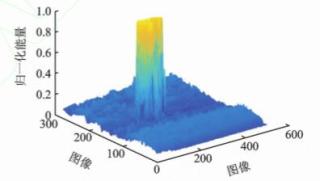图像能量图怎么计算,代码 matlab
图像能量图怎么计算,代码 matlab ,python也可以,但是要运行正确

MATLAB
能量计算方式,直接取平方,你可以根据自己的计算方式进行更改
close all;
clear all;
A = imread('lena.png'); %换成自己的图
GRAY_A = double(rgb2gray(A))./255;
ENG_GRAY_A=GRAY_A.*GRAY_A;%计算能量
[x1,y1] = size(ENG_GRAY_A);
X = 0:x1-1;
Y = 0:y1-1;
figure
mesh(X,Y,ENG_GRAY_A)
xlabel('图像x轴');
ylabel('图像y轴');
zlabel('归一化能量');

matlab
能量= sum(abs(details(:)).^2);
x = rand(64,64,16);
J = 1;
[Faf, Fsf] = FSfarras;
[af, sf] = dualfilt1;T=10;
w = dualtree3D(x, J, Faf, af);
details = w{1}{1}{1};
energy = sum(abs(details(:)).^2);
用surface
用python实现的:
import pandas as pd
import numpy as np
import matplotlib.pyplot as plt
import pywt
from mpl_toolkits.mplot3d import axes3d
from matplotlib.ticker import multiplelocator, formatstrformatter
# 解决负号显示问题
plt.rcparams['axes.unicode_minus'] = false # 解决保存图像是负号'-'显示为方块的问题
plt.rcparams.update({'text.usetex': false, 'font.family': 'serif', 'font.serif': 'cmr10', 'mathtext.fontset': 'cm'})
font1 = {'family': 'simhei', 'weight': 'normal', 'size': 12}
font2 = {'family': 'times new roman', 'weight': 'normal', 'size': 18}
label = {'family': 'simhei', 'weight': 'normal', 'size': 15}
xlsx_path = "../小波能量谱作图.xlsx"
sheet_name = "表名"
data_arr = pd.read_excel(xlsx_path, sheet_name=sheet_name)
column_name = '列名'
row = 1024
y = data_arr[column_name][0:row]
x = data_arr['time'][0:row]
scale = np.arange(1, 50)
wavelet = 'gaus1' # 'morl' 'gaus1' 小波基函数
# 时间-尺度小波能量谱
def time_scale_spectrum():
coefs, freqs = pywt.cwt(y, scale, wavelet) # np.arange(1, 31) 第一个参数必须 >=1 'morl' 'gaus1'
scale_freqs = np.power(freqs, -1) # 对频率freqs 取倒数变为尺度
fig = plt.figure(figsize=(5, 4))
ax = axes3d(fig)
# x:time y:scale z:amplitude
x = np.arange(0, row, 1) # [0-1023]
y = scale_freqs
x, y = np.meshgrid(x, y)
z = abs(coefs)
# 绘制三维曲面图
ax.plot_surface(x, y, z, rstride=1, cstride=1, cmap='rainbow')
# 设置三个坐标轴信息
ax.set_xlabel('$mileage/km$', color='b', fontsize=12)
ax.set_ylabel('$scale$', color='g', fontsize=12)
ax.set_zlabel('$amplitude/mm$', color='r', fontsize=12)
plt.draw()
plt.show()
# 时间小波能量谱
def time_spectrum():
coefs, freqs = pywt.cwt(y, scale, wavelet)
coefs_pow = np.power(coefs, 2) # 对二维数组中的数平方
spectrum_value = [0] * row # len(freqs)
# 将二维数组按照里程叠加每个里程上的所有scale值
for i in range(row):
sum = 0
for j in range(len(freqs)):
sum += coefs_pow[j][i]
spectrum_value[i] = sum
fig = plt.figure(figsize=(7, 2))
line_width = 1
line_color = 'dodgerblue'
line_style = '-'
t1 = fig.add_subplot(1, 1, 1)
t1.plot(x, spectrum_value, label='模拟', linewidth=line_width, color=line_color, linestyle=line_style)
# t1.legend(loc='upper right', prop=font1, frameon=true) # lower ,left
# 坐标轴名称
t1.set_xlabel('$time$', fontsize=15, fontdict=font1) # fontdict设置子图字体
t1.set_ylabel('$e/mm^2$', fontsize=15, fontdict=font1)
# 坐标刻度值字体大小
t1.tick_params(labelsize=15)
print(spectrum_value[269])
plt.show()
# 尺度小波能量谱
def scale_spectrum():
coefs, freqs = pywt.cwt(y, scale, wavelet)
coefs_pow = np.power(coefs, 2) # 对二维数组中的数平方
scale_freqs = np.power(freqs, -1) # 对频率freqs 取倒数变为尺度
spectrum_value = [0] * len(freqs) # len(freqs)
# 将二维数组按照里程叠加每个里程上的所有scale值
for i in range(len(freqs)):
sum = 0
for j in range(row):
sum += coefs_pow[i][j]
spectrum_value[i] = sum
fig = plt.figure(figsize=(7, 4))
line_width = 1
line_color1 = 'dodgerblue'
line_style1 = '-'
t1 = fig.add_subplot(1, 1, 1)
t1.plot(scale_freqs, spectrum_value, label=column_name, linewidth=line_width, color=line_color1, linestyle=line_style1)
# t1.legend(loc='upper right', prop=font1, frameon=true) # lower ,left
# 坐标轴名称
t1.set_xlabel('$scale$', fontsize=15, fontdict=font1) # fontdict设置子图字体
t1.set_ylabel('$e/mm^2$', fontsize=15, fontdict=font1)
# 坐标刻度值字体大小
t1.tick_params(labelsize=15)
plt.show()
# 通过调用下面三个不同的函数选择绘制能量谱
time_scale_spectrum()
# time_spectrum()
# scale_spectrum()